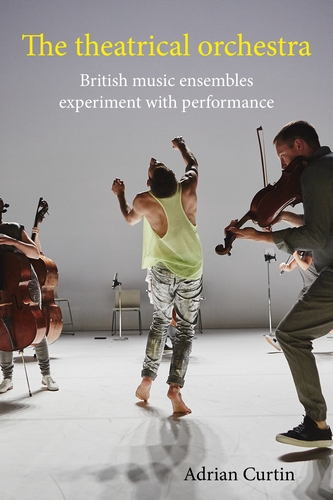Posted by Adrian Curtin
30 April 2025My book The Theatrical Orchestra: British Music Ensembles Experiment with Performance has been published by Manchester University Press.

The Theatrical Orchestra focuses on the work of eight British ensembles – Aurora Orchestra, London Contemporary Orchestra, London Sinfonietta, Manchester Collective, Multi-Story Orchestra, Paraorchestra, Scottish Ensemble, and Sinfonia Smith Square (formerly Southbank Sinfonia) – that have engaged in theatrical presentation of orchestral music and cross-artform collaboration. Each of the main chapters discusses the work of two or three ensembles in a comparative manner. I delve deeply into performance examples, treating them as unique stage compositions, analysing them as a theatre scholar might analyse a theatrical production: attending not just to textual components, but also to ‘extra-musical’ signifying elements, experiential qualities, and cultural resonance.
Chapter 1 discusses fundamental aspects of theatre – stagecraft and spectacle – that are not usually emphasised or elaborated upon in conventional orchestra concerts, but are increasingly used by groups willing to go beyond the standard concert rituals and modes of presentation. Chapter 2 examines the orchestra as storyteller, outside the context of music that has a narrative or descriptive meaning attached to it. Chapter 3 investigates orchestras engaging in choreographed movement, beyond that which is involved in playing instruments in a coordinated fashion. Chapter 4 treats orchestral performance in which location is an integral part of the meaning of the event and music interacts dynamically and idiosyncratically with place, making it into a ‘scene partner’. Chapter 5 explores ‘immersive’ performances in which audience members are invited to position themselves within an orchestra as it plays. The concluding chapter goes behind the scenes, re-examining the processes by which theatrically oriented orchestral performance are made, and includes practitioner commentary drawn from interviews featured in an accompanying podcast series.
Throughout the book I make a case for the artistic integrity of the featured music ensembles that have experimented with presentation and cross-artform collaboration. I argue that when orchestral performance is presented theatrically, the affective potential of music can be realised more fully and a myriad of meanings can be generated. My book tells a story about orchestras that are connected to the world around them and have something to say about it, orchestras that are plugged into contemporary culture and are excited to share music they love with as many people as possible from all walks of life, and to do so in ways that are possibly unexpected, fresh, engaging, and memorable. I hope that that readers of my book will better understand this cultural development and will be inspired by it, as I have been.